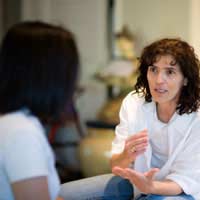Lip Reading

After sign language lip reading is one of the most common ways for deaf people to communicate. The obvious problem with lip reading is that it is not a complete communication system in itself as it only allows the lip reader to understand and not to make conversation themselves. But if a person is good at lip reading then they will be able to follow conversations – of course, as long as they can see the people who are speaking clearly, and usually, as long as the people are aware of the lip reader so they can slow down – some people are good enough not to need this however. And just as some people make good lip readers, some people make good subjects of lip reading. People who speak very fast tend not to open their mouths very wide, thus obstructing the lip reader’s understanding, while slower speakers make more distinct shapes – helping the lip reader along.
Watching the Way Words are Formed
Like all systems, lip reading has some disadvantages. For the most part, lip readers can see where their subject is forming the words – not only in the lips, but the face too. In fact, most of us do this on some level when talking face to face, we just do not realise it. But lip readers base their whole understanding of what has been said on these movements. Which is fine until a word or letter is used which is made from inside the mouth – and thus out of vision for the lip reader. So words with letters which look the same – notably p and b, can be confusing. It has been estimated that as many as 40 per cent of sounds in English cannot be told apart from others just by lip reading. This is a daunting figure and seems at first to render lip reading virtually useless But there are ways a round it. Much of the time the meaning will be clear from context but this is not always the case.The Speaker’s Face
As mentioned above, another disadvantage is that if a speaker’s face is obstructed, the lip reader will not be able to make anything out. This does not only extend to speakers who are turned away form the lip reader but also people who have moustaches and beards as this can obstruct the facial positioning.Finally, in a group discussion, lip reading becomes very difficult because it is not easy to see the person who is about to speak next. Thus by the time the lip reader trains their eyes on them, they have already probably missed some words, maybe even more.
Lip reading is a skill which takes a long time to perfect but becomes invaluable once learnt. It is not only deaf people who will find it a good skill to have – anyone who works in a noisy environment should at least attempt to learn how to watch someone’s face for what they are saying. In this way, you avoid having to yell at the tops of your voices to each other, or, more dangerously, do not have to take off protective safety ear protectors.
- How Much Do Courts Spend on Sign Language
- Holidays With a Difference: Signed Cruises
- Story Telling in Sign Language
- The American Sign Language Bill and its Repercussions
- Use of Sign Language in the Police Force
- Prisons' Use of Sign Language
- Sign Language Among Scuba Divers
- Sign Language in Religious Communities
- Using Sign Language for Work
- Using the Internet to Learn Sign Language
- Sign Language and Public Services
- Written Forms of Sign Language
- My Signing Experiences as a Deaf Person: A Case Study
- Use of Signs in Hearing Communities
- Sign Language in the Workplace
- Nicaraguan Sign Language Created by Children
- How to Convey Emotion
- How to Communicate with Deaf People


Re: The Listening Bus
Hi, We would like to book the listening bus for our school community. What is your availability for the summer term 2025? What are the costs? We…
Re: Sign Supported English
Ex Mary hare school. Love sign supported English as Aspie. More useful Less emotional As words Not emotion More helpful to deaf Aspies
Re: The Listening Bus
Hi, I am the inclusion leader and SENCo of a school with a specialist resource provision for deaf pupils within a mainstream school. Staff say…
Re: The British Sign Language Broadcasting Trust
I’m not effected in any way or suffer from any communication issues personally. I was curious as to why…
Re: Sign Supported English
I want a series of videos to learn SIGN SUPPORTED ENGLISH FOR BEGINNERS. Can you please help?
Re: Makaton
Hello We are a small pre-school and we are trying to teach all our children Makaton to help all of them communicate regardless of their own…
Re: Sign Supported English
Can anyone help me ? I am trying to find an SSE class or lessons in Kent and have had no luck. Failing that, are there any publications I…
Re: Hands on Signing
Hi I have a blind child and he has a moderate hearing loss. I wonder if you can help me to teach him sign language and I need to learn as well.…
Re: Sign Supported English
Does anyone know of any programmes or resources for using SSE with older people whose hearing has deteriorated in later life?
Re: Makaton
what is makaton??????????????????????????